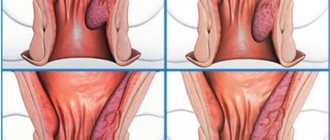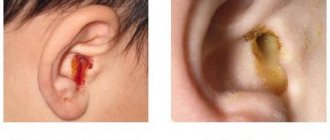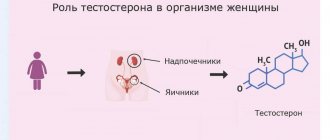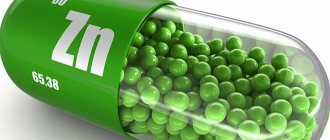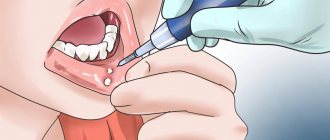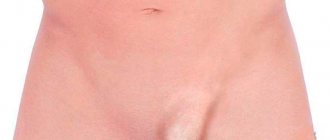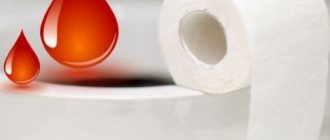Types of bleeding and their elimination
Hemorrhoidal bleeding can be scanty or profuse.
Scanty bleeding is characterized by the appearance of several spots of blood on linen or paper after visiting the toilet.
Heavy bleeding begins with the loss of 1-2 ml of blood. But if left untreated, it can quickly progress to the stage of massive blood loss, which poses a great threat to health.
To eliminate bleeding, you need to wash yourself with cool, but not cold water, otherwise paraproctitis may be added to hemorrhoids. This brings instant relief as the inflamed nodes shrink in size, closing the outlet for blood.
After washing, it is necessary to apply an ointment that has anti-inflammatory and anticoagulating effects to the affected area.
At the initial stage of the disease, the use of such medications eliminates symptoms, and with advanced hemorrhoids, it alleviates the patient’s condition, reducing swelling of the anal mucosa, soothing pain and relieving burning.
Bleeding is a sign that a fissure has appeared in the anus. If no action is taken to treat hemorrhoids, over time it will be complicated by anemia, up to severe severity with hemoglobin less than 80 g/l, chronic reflex constipation, and can transform into a bleeding tumor.
Regardless of whether the bleeding is scanty or heavy, you must immediately consult a doctor! You can consult online with a therapist or proctologist.
Tablets for hemorrhoids with bleeding
The optimal tablets designed to eliminate bleeding from hemorrhoids are listed in the table.
| Medicine | Tablets per dose | Daily dose | Treatment course, days |
| Phlebodia 600 | 1 | 3 | 7 |
| Venolek in the acute phase | 3 | 2 | 3 |
| Venolek in the chronic period | 2 | 2 | 3 |
| Detralex 500 mg in the acute period | 3 | 2 | 5 |
| Detralex in the chronic period | 2 | 2 | 4 |
| Venarus in the acute phase | 1 | 2 | 3 |
| Venarus in the chronic period | 1 | 2 | 3 |
The tablets used act not only on hemorrhoids. They are effective for varicose veins and a predisposition to the formation of blood clots.
Treatment of hemorrhoids accompanied by slight bleeding
To cope with the disease, it is important to find the right method of dealing with it. Some people benefit from diets and suppositories, while others need surgery.
At the first manifestations of the disease, you must adhere to simple rules of nutrition and hygienic care.
Diet food
Review your diet by eliminating everything fatty, fried, spicy, pickled, as well as desserts, coffee and alcohol.
The daily diet should include cereals (with the exception of semolina, rice and corn), soups with a mucous consistency, stale or dried bread, lean meat or dietary fish, steamed, drinking plenty of fluids (decoctions of berries and herbs, non-acidic natural juices).
Taking cool baths
As a bath, it is best to use decoctions of herbs with anti-inflammatory or astringent effects - chamomile, calendula, oak bark.
The decoction for each procedure must be freshly prepared and sufficiently cooled. You need to sit in it every day for 10-15 minutes. As an alternative to baths, wiping the anus with a piece of ice is used.
Replacing toilet paper by flushing
Since the main reason for non-healing of erosion in the anus is the entry of feces into the wound, they must be disposed of after each act of defecation by regular washing.
Use of topical medications
Ointments and suppositories will not cure on their own if the disease is advanced and progresses. But if used regularly at the initial stage, they can help.
A good remedy for bleeding hemorrhoids is suppositories with sea buckthorn oil.
Blood in the stool: possible causes
People usually do not attach importance to the process of defecation, and even less so to its result. However, sometimes it is still worth paying attention to your own stool, so as not to miss changes that require medical intervention. So, blood in the stool is often not only a bright, but also a menacing messenger of possible trouble, and you need to know the enemy by sight.
Where can blood come from?
Normally, at the end of the digestive act, masses of a uniform color are formed due to pigments. There is no blood, or more precisely, red blood cells. If at any stage the integrity of the epithelial cover and the blood vessels underneath is compromised, the red blood cells mix with the contents and change the color of the stool at the exit depending on their number and the location of the bleeding.
The bright red color of stool is given by unchanged red blood cells, which signal problems in the lower gastrointestinal tract - the large intestine. Bleeding from the esophagus, stomach or small intestine looks different - red blood cells are exposed to hydrochloric acid, enzymes and intestinal contents and turn the stool dark red or red-brown. Such a change is not always visible to the naked eye and requires laboratory confirmation methods, so we will look at the main reasons for the appearance of unchanged blood in the stool.
Haemorrhoids
One of the most common causes is hemorrhoids, which affects about 10% of the adult population aged 30 to 50 years. This disease affects men several times more often.
Special veins - cavernous bodies - become deformed and enlarge, forming the well-known hemorrhoids under the intestinal mucosa. Since they are abundantly supplied with blood and, unlike other veins, have a connection with arteries, when the intestinal wall is damaged, the blood is released scarlet, does not mix with feces, or leaves bright marks on toilet paper.
Hemorrhoids “bleed” after defecation. Bleeding from hemorrhoids is the main manifestation of this insidious disease. It does not stop well and, if prolonged, can lead to the development of anemia, so it deserves close attention.
Cracks
Another problem in the anus is an anal fissure. It is a tear where the rectal mucosa meets the skin. And since the integrity of the cover is broken, the appearance of blood will not be long in coming. But in this case, blood is released in droplets, not as abundantly as with hemorrhoids, and small stripes on the surface of the stool are noticeable in the stool. This phenomenon is not always obvious; a sharp, even burning pain during defecation, which often lasts several hours after it, can be more alarming.
Oncology
Rectal cancer is one of the most “evil” cancer diseases. It develops unnoticed for a long time, and in this situation, paying attention to yourself will be a good help, since the main early manifestation of the disease is blood in the stool.
Bleeding in cancer is caused by ulceration of the tumor surface and traumatization by feces; it is rarely massive and more often looks like a small amount of dark red impurities. But you should not be immediately alarmed if you discover something like this, since this is only one of the signs and it is necessary to take into account pain, the presence of mucus in the stool or difficulties in defecation, as well as general symptoms. A doctor will help you figure it out.
Ulcer
Nonspecific ulcerative colitis also causes bleeding and the appearance of red blood cells in the stool. The very name “ulcerative” indicates the formation of a defect - “ulcer”, which in this disease affects the mucous membrane of the colon.
UC, as doctors affectionately call it, occurs with periods of exacerbation, when inflammation acquires pronounced features. As a result, the capillaries of the mucous membrane expand, the epithelium becomes necrotic, and blood appears in the stool. At the same time, the very nature of the stool changes - it becomes more frequent, thins out, and patients are often bothered by “bloody” diarrhea. Blood in the stool can be either abundant, covering it, or in the form of impurities - it all depends on the extent of the lesion.
This disease is often accompanied by anemia, since the intestine bleeds every time there is an exacerbation, and in some cases there is no relief at all.
Intestinal inflammation
Another inflammatory disease characterized by blood in the stool is proctitis, i.e. inflammation of the rectal mucosa. The causes of proctitis can be very different, from radiation to parasites, and it is always important to find out them in order to successfully fight the disease. The nature of the stool will help suggest proctitis - bloody discharge in the form of impurities, usually light.
Treatment of hemorrhoids accompanied by heavy bleeding
When hemorrhoids are inflamed and enlarged, blood can flow in a stream not only when visiting the toilet, but also with any sudden movement or physical stress.
In this case, you need to take effective medications. Remember that only your attending physician can prescribe them, taking into account the course of the disease and the individual characteristics of the body.
Treatment methods for hemorrhoids with heavy bleeding:
- Taking tablet medications.
- The use of anti-inflammatory ointments and suppositories. Inexpensive candles (average price 50-120 rubles): Belladonna extract, Anuzol, Methyluracil, Betiol. The most effective (300-600r): Relief, Procto-glivenol, Ultraproct, Nigepan, Proctosan, Hepazolon. In some cases, injections of hemostatic drugs.
Doctor's advice
Everyone has heard that there is food that strengthens, and there is food that weakens. But people often confuse the properties of their usual food products. It is worth paying attention to the ability to produce gas - this can contribute to additional discomfort with hemorrhoids.
Victoria Druzhikina Neurologist, Therapist
- If there is a risk of anemia, take vitamins C and K, as well as preparations containing iron.
- Sclerotherapy using medications.
- Radical measures are surgery. It is used in cases where other methods do not produce results or their use is futile, the decision is made by the surgeon.
If you are in doubt about which candles to choose, consult your physician.
Diet for hemorrhoids with bleeding
To speed up recovery and prevent periodic exacerbations of pathology, it is recommended to adhere to a diet according to the following rules:
- introducing plenty of plant foods containing fiber to prevent constipation;
- eating dried apricots, raisins, prunes, they stimulate intestinal motility and soften stool;
- drink a lot of water, dried fruit compotes (at least 2 liters of any liquids per day);
- for breakfast they eat porridge made from rice, millet, semolina, buckwheat (porridge should be made with milk, you can add dried fruits);
- prepare simple soups with a small content of meat products, of which beef and chicken are preferable;
- for lunch 2 times a week they eat fish, which needs to be baked or stewed; frying is not recommended;
- exclude foods that cause stress on the gastrointestinal tract - legumes, soda, alcohol, baked goods.
It is better to choose a diet only by your doctor. He will take into account the patient’s medical history and create the correct diet that does not harm the intestines.
If a patient is diagnosed with hemorrhoids, treatment must be carried out only under the supervision of a therapist, proctologist, or surgeon. Often hemorrhoids become very inflamed, leading to bleeding. In this case, you need to start complex therapy, consisting of medications, plant extracts, and optimal physical activity. Hemorrhoids are often found in pregnant women or women who have recently given birth. Treatment should be carried out under the supervision of a physician, since some medications are inadmissible during this period. If hemorrhoids are not strictly controlled, a complication develops. It can go into a chronic stage, which will bring pain to the patient, difficulty in defecation and other complications.
Treatment of hemorrhoids during pregnancy
Every second woman suffering from inflammation of hemorrhoids developed this disease during the most wonderful period of her life - during pregnancy.
Developing in the mother's womb, the fetus affects blood circulation and intestinal function, causing various problems, including hemorrhoids. The disease may appear in the last months of pregnancy or after childbirth.
Factors that can trigger the appearance of hemorrhoids during pregnancy:
- weakness of the rectal muscles;
- tendency to constipation;
- abuse of fatty and spicy foods;
- increased physical activity.
To prevent the occurrence of hemorrhoids during pregnancy, three conditions must be met - avoidance of spicy foods, a minimum of physical activity and normalization of stool.
For mild hemorrhoidal inflammation, ointments, creams and suppositories are used, paying attention to their composition: the drugs should not have a toxic effect on the fetus.
The best option are candles:
- suppositories can be bought at any pharmacy without a prescription;
- suppositories have a complex effect - they not only relieve pain, but also help eliminate constipation and flatulence, eliminate unpleasant obsessive itching in the anus;
- are easy to use and allow a woman to take care of herself independently, even in the last months of pregnancy, when medical procedures are complicated by a protruding belly.
Causes of hemorrhage
The main damaging factors leading to hemorrhoids and areas of bleeding are identified.
- Prolonged constipation
. Excessively hard stool leads to stretching and deformation of the intestinal walls. Large nodes form and begin to become inflamed, releasing blood. The regeneration process takes a long time, as prolonged pressure and mechanical damage are maintained. Blood is released with every bowel movement. - Reduced tone of the vascular endothelium
. With heart failure, atherosclerosis, diabetes mellitus and other pathologies, the vascular endothelium becomes weak. Constant constipation and other damaging factors in the intestines cause increased compression of blood vessels. Anal fissures form, from which blood often leaks. - Active, strong efforts
during bowel movements. The excretion of feces is accompanied by blood and severe pain. - Anal intercourse
. This is a strong damaging factor, leading to inflammation and bleeding. Areas of damage can occur even in patients without hemorrhoids. - Prolonged diarrhea
. Severe diarrhea leads to chronic irritation of the intestinal wall. Its vessels become thinner, the mucous membrane becomes covered with cracks. Hemorrhoids become very inflamed and bleed. - Prolonged sitting position
. The absence of even minimal physical activity leads to blood stagnation and vascular damage.
Hemorrhoids are caused by damaged veins that become deformed under the influence of strong pressure. Their walls compress, the blood pressure inside increases. Local circulatory disorders occur, and hemorrhoidal cones gradually develop.
Medicinal herbs for the treatment of hemorrhoids
Our grandmothers also used herbs with enveloping, anti-inflammatory and astringent effects to treat hemorrhoids, which are very effective for use at home.
To the already mentioned chamomile, calendula and oak bark, you can add yarrow, blueberries, and wheatgrass root. Decoctions from these plants are suitable for both baths and mini-enemas.
Aloe juice has a therapeutic effect in the fight against hemorrhoids, preventing inflammation and healing cracks. All herbs should be started at low concentrations to avoid possible allergic reactions if tolerance to a particular herb is unknown.
Juice and gruel from raw potatoes are used with great success in the treatment of hemorrhoids. Potatoes can stop bleeding, speed up the healing of cracks, and restore the condition of the rectal mucosa.
Hemorrhoids are a very unpleasant disease that causes discomfort. As the disease progresses, bleeding may occur. To avoid this, do not start the disease, but at the first symptoms, contact a specialist who will prescribe effective treatment, taking into account all the characteristics of your body.
Traditional methods of therapy
Traditional methods of therapy should be used as additional treatment. The main remedy remains medications prescribed by a doctor. The extracts used should be used only with the permission of the proctologist.
Calendula infusion
Method of preparing medicinal tincture:
- a tablespoon of the dried plant is placed in a container;
- pour 200 ml of boiling water;
- cover with a lid and leave for at least 2 hours;
- strain the liquid.
The resulting medicinal infusion is used for 2 methods:
- washing;
- microenema.
To make a microenema, you need to draw 40 ml of liquid into a sterile container. The solution is injected through the anus and held for 20 minutes. To prevent it from leaking out before this time, lie on your stomach. The technique is applicable for 10 days in a row.
Chamomile decoction
To cause a therapeutic effect, a decoction is first prepared according to the following method:
- pour 1 tablespoon of dried herb into the container;
- pour 200 ml of water;
- cook in a water bath for 30 minutes, without bringing to a boil.
Microclysters are carried out in stages:
- 50 milliliters of solution is administered through the anus;
- leave to infuse for up to 20 minutes, lying on your stomach;
- repeat the procedure 3 times a day for 1 week.
Chamomile has an anti-inflammatory and regenerative effect.
Yarrow decoction
Method for preparing a decoction from a medicinal plant:
- 1 tablespoon of raw materials is placed in a container, pour 250 ml of boiling water;
- simmer for 20 minutes, do not boil;
- leave for 2 hours, filter.
If the liquid becomes cool, add warm boiled water. Then use according to the following rules:
- a sterile bandage or gauze is soaked in the liquid;
- apply to the affected area for 20 minutes;
- You can use an enema of 30 ml of liquid 3 times a day.
The duration of the therapy period is 7-10 days.
If the patient’s health worsens and a large amount of blood is released, medications are initially used. When the condition stabilizes a little, the therapy is supplemented with plant extracts. If you use combined treatment, intestinal recovery will occur much faster.
Product table
| The product's name | Fastens | Weakens | Gives gas formation |
| Cabbage | + | + | |
| Whole milk | + | + | |
| Sour milk | + | ||
| Beet | + | ||
| Bakery | + | ||
| Peas | + | ||
| Egg | + | ||
| Semolina | + | ||
| Cream | + | ||
| Potato | + | ||
| Fatty meat | + | + | |
| Plum | + | ||
| Chokeberry | + | ||
| Pear | + | ||
| Black bread | + | ||
| Rice | + | ||
| Pomegranate | + | ||
| Apricot | + | ||
| Persimmon | + | ||
| Black tea | + | ||
| Walnut | + |
Find out about the most effective candles from the video:
This article has been verified by a current qualified physician, Victoria Druzhikina, and can be considered a reliable source of information for site users.
Bibliography
1. https://www.gastroscan.ru/literature/authors/9497
Rate how useful this article was
4.3 15 people voted, average rating 4.3
Did you like the article? Save it to your wall so you don’t lose it!

